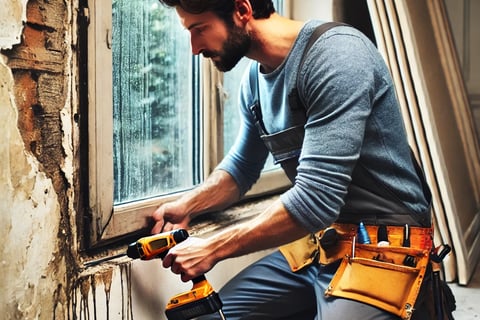Windows Matter: How Proper Maintenance Reduces Energy Costs
When facility managers and property owners look for ways to reduce energy costs, windows often get overlooked. HVAC systems, insulation, and lighting upgrades tend to take center stage, but inefficient or poorly maintained windows can be a silent drain on energy expenses. Commercial buildings, whether office spaces, retail stores, or multifamily properties, rely on well-sealed, properly functioning windows to regulate indoor temperatures. Ignoring window maintenance can lead to excessive heating and cooling costs, employee discomfort, and even structural issues down the line. Let’s break down why window maintenance should be a priority and how simple, cost-effective strategies can lead to significant energy savings
Martin Hunsinger
3/11/20253 min read


How Windows Impact Energy Costs
1. Air Leaks Waste Energy
Even small gaps in window seals can allow conditioned air to escape, forcing HVAC systems to work harder to maintain a stable temperature. According to the U.S. Department of Energy, heat gain and loss through windows account for 25–30% of a building’s heating and cooling energy use.
For facility managers, this means higher energy bills and increased wear on HVAC equipment. Over time, this added strain leads to more frequent repairs and premature system replacements.
2. Inefficient Glass Raises Heating and Cooling Loads
Older single-pane or untreated windows do little to insulate a building. Heat transfer through inefficient glass can cause uneven temperatures, making some areas too hot in summer or too cold in winter.
Upgrading to double-pane, Low-E coated, or insulated glass can significantly reduce this heat transfer. While full window replacements may not always be feasible, window films and insulating treatments can improve efficiency at a fraction of the cost.
3. Sunlight and Glare Affect HVAC Performance
Direct sunlight streaming through unprotected windows can cause “hot zones” in a building, forcing air conditioning systems to compensate. This not only raises energy consumption but also reduces occupant comfort—leading to thermostat battles and complaints.
Installing window shades, tinting, or automated blinds can help regulate sunlight exposure, keeping interiors cooler without overburdening HVAC systems.
Preventative Maintenance: The Key to Energy Savings
Regular window maintenance is one of the most cost-effective ways to improve energy efficiency without major capital expenditures. Here’s what property managers should prioritize:
1. Inspect and Seal Window Gaps
Check for drafts by feeling around window edges or using an infrared thermometer.
Apply weatherstripping or caulk to seal any leaks.
For larger gaps, consider using foam sealants or window inserts.
2. Repair or Replace Damaged Components
Cracked or foggy glass reduces insulation and should be replaced.
Warped or rotting window frames (common in older wooden windows) compromise sealing and structure.
Sticking windows may indicate warped frames or failed balances—fixing them improves longevity and efficiency.
3. Optimize Window Treatments
Use thermal curtains or blinds in extreme weather seasons.
Install solar control film to reduce heat gain while maintaining natural light.
Consider automated shading systems that adjust based on sunlight levels.
4. Clean Windows and Tracks Regularly
Dirt buildup in window tracks can prevent proper sealing.
Hard water stains or grime on glass can reduce light transmission and affect solar heat gain.
Keeping windows clean ensures they function as intended and last longer.
When to Consider Window Upgrades
While maintenance can extend the life of existing windows, some situations call for full replacements:
✅ Windows are over 20 years old and showing signs of structural failure.
✅ Consistent draft issues despite repeated sealing and repairs.
✅ High energy bills persist, even after other efficiency improvements.
✅ Condensation between panes indicates seal failure, reducing insulation value.
In these cases, upgrading to energy-efficient windows (such as ENERGY STAR-rated models) can provide a long-term return on investment by lowering energy costs and improving building performance.
The ROI of Window Maintenance for Facility Managers
Facility managers and property owners are always looking for cost-effective ways to improve energy efficiency. Regular window maintenance offers:
✔ Lower energy bills—Preventing air leaks and optimizing insulation reduces heating/cooling expenses.
✔ Extended HVAC lifespan—Less strain on the system means fewer repairs and longer equipment life.
✔ Improved occupant comfort—Stable indoor temperatures lead to fewer complaints from tenants or employees.
✔ Preserved property value—Well-maintained windows enhance curb appeal and reduce costly structural damage.
Final Thoughts: Don’t Overlook Windows in Your Energy Strategy
Windows play a crucial role in a building’s energy efficiency, yet they’re often neglected until problems become too big to ignore. By implementing a proactive maintenance plan, facility managers can cut costs, improve comfort, and reduce the environmental footprint of their buildings—all without major renovations.
Want to assess the efficiency of your building’s windows? Start with an inspection, seal any gaps, and explore cost-effective upgrades to keep your facility running at peak performance.
What’s Next?
Need help with commercial handyman services? Contact us to inspect and maintain your property’s windows.
Want energy savings insights? Share your biggest efficiency challenges in the comments!


